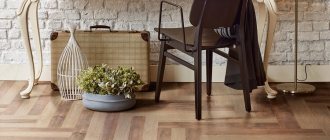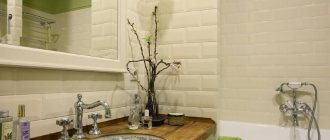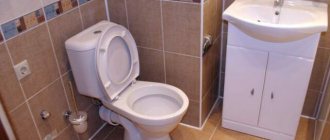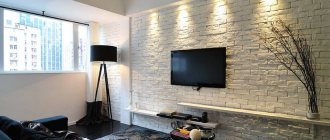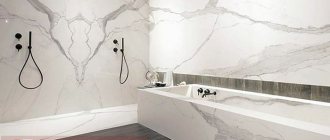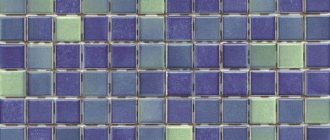It is perhaps difficult to name a more common finishing material than tiles, and this popularity is largely due to its diversity - ceramics and glass, natural stone and porcelain stoneware, vinyl, quartz vinyl and PVC, leather and metal, wood and even rubber. There are so many different materials that tiles are made from and wherever they are used – on walls, on ceilings, on floors, in the interior, on the facade, in landscape design. Despite the huge number of varieties of this material, differing in raw materials, shape and texture, all tiles are similar in installation technology - with a seam. However, recently, seamless tiles, which, after laying, form a monolithic coating, have become increasingly interesting among consumers. We’ll tell you what’s special about it and how to work with this cladding in this material.
Is it possible to lay tiles without seams?
Of course you can lay tiles without seams! Seamless tiles are currently in great demand. It does not require additional effort and time for grouting joints and at the same time allows you to create a complete, uniform surface of a wall or floor.
Today, seamless floor tiles are very popular, which allows you to create a chic relief surface.
Briefly about the main thing
When deciding whether it is possible to lay tiles without seams yourself, you need to focus not so much on the desire to save money, but on the complexity of this work. And correctly assess your abilities. This expensive material is worth the money, and the coating made from it looks solid, lasts a long time, and does not need repairs. But only subject to high-quality installation and the right location. Rectificate should not be placed in bathrooms, on cold terraces, or on warm floors. Its scope of application is residential premises with a stable microclimate.
Ratings 0
What is rectification
The rectification process involves additional leveling of the edges of the finished ceramic tiles using diamond cutters using high-precision equipment.
Rectified porcelain tiles are tiles with cut ends.
To rectify the material, pressed and fired elements made from porcelain stoneware undergo a trimming process to give them a perfectly even rectangular shape. This technology is intended to produce a monolithic ideal floor or ceiling surface from ceramic elements used during cladding work.
Externally, it differs from the usual one in the absence of chamfers on the sides.
Why are stitches needed?
Traditionally, tilers make identical joints between the tiles, which are then sealed with grout. The same thickness of the seam can be achieved using plastic crosses.
What purpose do the seams serve?
- Ceramics are made from clay and tend to expand when exposed to moisture or temperature changes. So if you are laying ceramics in the bathroom or on a kitchen splashback, you cannot do without seams: the seams allow the tile to “play.”
- Joints allow you to play with contrast and create interesting visual effects. Light ceramics and dark grout look unusual and original, and the combination of red ceramics and blue joints is extravagant.
- Wide joints help hide errors in the dimensions of ceramic tiles. If the dimensions differ by several millimeters, tiles without seams will highlight these defects.
Advantages and disadvantages of seamless tiles
Rectified porcelain tiles have many advantages compared to conventional ceramic tiles:
- There is no need to use grout. Since there are no seams, no time is required to install joints between tiles.
- The absence of seams between the ceramics prevents the accumulation of harmful microorganisms and dirt.
- An impeccable monolithic surface adds aesthetic appeal and presentability to the design of the room.
The craftsman requires high qualifications to ensure high-quality installation of this material.
However, no matter how ideal seamless tiles may seem, they still have some disadvantages:
- Highly qualified specialists must work with such material, since the installation process requires very precise actions and calculations.
- Not every surface is suitable for laying with this material.
- Irregularities in the facial surface of the ceramic can lead to additional difficulties.
- Temperature changes can negatively affect the service life of porcelain stoneware.
Seamless floor tiles can have both small and large patterns, reminiscent of marble or granite.
Before using seamless ceramic tiles, it is necessary to evaluate all the shortcomings of the base on which it will be laid. The ideal base is a durable and even concrete surface.
For seamless cladding of walls, ceilings and floors, the best option is large-format rectified porcelain tiles.
It allows you to accurately form a perfectly smooth, uniform surface.
So, for example, large ceramic tiles are ideal for exceptional cleanliness of seamless bathroom coatings. They will help you create a single, laconic design of the entire room, using slabs of the same size for cladding the floor, ceiling and walls of the bathroom.
Such tiles are not afraid of exposure to detergents and are very easy to care for.
Mandatory surface preparation
To lay tiles using the seamless method, you need to bring the floor surface to perfect condition.
For the best effect, the floor must be perfectly level.
This is not an easy technique. If the slightest unevenness appears, then it will not be possible to fold the edges without seams.
Before laying, you need to level the floor, make a cement screed or pour a self-leveling mixture.
If the surface is inclined or vertical, then you will have to plaster it. In case of complex unevenness, it is necessary to cover the wall with a sheet of plasterboard. Afterwards a metal mesh is attached. The surface is ready for laying tiles without seams.
Types of tiles without seams
Seamless tiles very often imitate natural stone - it can be marble or granite; it looks very impressive in large, spacious rooms. Tile imitating concrete fits perfectly into loft-style interiors.
Seamless floor tiles can be used to finish ceilings in private houses, apartments, public facilities, etc.
For the floor option, seamless tiles with wood imitation are often used - they will give the interior a feeling of comfort and warmth.
Seamless tiles are most often produced in large formats - starting from 45x45 cm. They look most impressive on large spaces of floors or walls.
This coating is quite difficult to install. You need to have special glue.
There are other formats: 20x60 or 30x90 centimeters. The dimensions of large-format tiles are 1.5x3 meters.
How to choose the right quality seamless tiles and adhesive for them
Manufacturers of finishing materials almost always specify a specific adhesive for the porcelain tiles they produce. Do not neglect the manufacturer’s advice: they indicate the required adhesive based on the composition of the components included in a given batch of tiles. Since seamless tiles are quite an expensive product, it is better not to skimp on glue, otherwise you can lose much more by getting poor-quality cladding of the room. The latter can sometimes even lead to injury.
Only a professional can perform high-quality installation. If you do it incorrectly, then the drawing will not converge and discrepancies will be visible.
When choosing tiles, you need to pay attention to some details:
- All tile elements must belong to the same batch and production series; they are indicated on the product packaging. Otherwise, you may end up with the wrong pattern or the wrong shade, which will be very noticeable on the floor or wall.
- It is necessary to carefully inspect each tile to ensure that there are no microcracks, scratches or chips.
- High-quality porcelain tiles should have perfectly smooth edges and uniform dimensions.
- Several types are suitable for seamless installation, differing in strength and reliability - this information should be specified on the labeling.
- For seamless masonry, porcelain stoneware or lithoceramics are used.
- It must be taken into account that tiles with a rough surface are selected for flooring, and tiles with a smooth and glossy surface are selected for walls.
- It is advisable to buy 10% more tiles, just in case.
The use of seamless tiles is one of the most expensive and beautiful options for high-quality floor organization in an apartment or office.
What porcelain tiles can be used for seamless installation?
Tiles with any surface are subject to rectification. It can be matte, polished, satin or structured porcelain tile cladding. There are strict rules that must be followed so that the seamless laying of porcelain tiles looks impressive and does not spoil the interior of the room:
- It is necessary to select the facing material in accordance with the spatial parameters of the room. You should not choose pompous or dark colors for an office or small room. Pompousness is inappropriate in a small room, and a dark surface will make it visually even smaller.
- When laying rectified porcelain tiles in a seamless manner, sometimes difficulties arise with selecting a pattern, so if it is not possible to purchase material with a good supply, it is better to choose an abstract design or a plain one. A material that imitates natural wood, stone or leather is also suitable.
- Floor surfaces must be finished with a material whose characteristics meet the requirements for floors in a particular room. For example, for a kitchen or bathroom you should give preference to a matte, rough surface. When tiling floors in saunas, massage parlors, and swimming pools, where water and other liquids may get on the floor, you need to choose porcelain tiles with an anti-slip surface.
- It is better to cover the floors of industrial enterprises and production workshops with rectified technical porcelain stoneware with a matte surface, which is characterized by high strength characteristics, wear resistance, durability and ease of maintenance.
- The material is selected according to format and caliber, as well as in accordance with the dimensions of the surface to be tiled and the design of the tile layout. It is advisable to purchase cladding with a small margin, since tiles from other batches may differ in shade or caliber.
- The format, color and type of surface of the tile depends on the developed design. Following the calculated consumption, you should buy all the components of the future cladding, including decorative porcelain stoneware inserts with the appropriate pattern. You also need a small supply of each type of tile.
Tools for laying floor and ceiling tiles
To lay ceramic floor or ceiling seamless tiles, you will need the following tools:
- construction mixer;
- building level and measuring tools;
- glue container;
- spatulas (notched and rubber);
- grinder with diamond blade;
- suction cups, marker, plastic crosses.
All work, both preparatory and laying seamless tiles, is carried out according to the same technological methods as for ordinary tiles.
Necessary materials:
- porcelain stoneware;
- sealant, grout, glue, primer.
How to lay tiles without seams
Seamless laying is a more labor-intensive process than conventional laying with seams, which hide not only the errors of the tiles, but also possible inaccuracies in the work of the master. Working with rectified material requires special scrupulousness and precision, since in this case the master does not have a reserve of additional millimeters.
Try to glue the elements to each other as tightly as possible.
When laying seamless tiles, the influence of thermal changes and displacement caused by shrinkage of the building should be taken into account. Installation is possible in rooms with a uniform temperature; in this case, you should forget about warm floors (it is better to use installation with joints of 0.5-1.5 mm). Seamless installation is also not recommended in new buildings that have not undergone shrinkage.
Installation of this facing material can only be carried out on a level base that has sufficient strength.
Even with the most dense installation, grouting is possible - it will help hide the tonal difference between the elements of the slabs. The fugu must be selected that is elastic and has high adhesion. It is better to choose the tone of the grout in perfect combination with the tiles so that the seams are completely invisible.
With the help of seamless tiles, it has become possible to create timeless interiors.
The best way to get rid of seams is to lay very large format slabs, especially in small rooms. For example, finishing a bathroom can be done without any gaps between adjacent elements. The dimensions of the slabs can reach up to 3x1.5 meters. However, this cladding option is very expensive. The next drawback is the obligatory help of a second person; it is simply unrealistic to cope with large-format tiles alone.
The tile perfectly imitates marble, natural stone, and other types of materials.
Preparatory stage
Laying seamless tiles, just like regular tiles, begins with careful preparation of the base. The surface must be free of cracks, chips, depressions or bumps, without the slightest deviation anywhere in the room. The ideal base is a concrete screed; it will extend the life of the porcelain stoneware. For a high-quality coating, you need to sift the sand and use only fresh cement, since over time it loses its qualities.
The screed can be either an ordinary sand-cement mortar prepared by hand, or a ready-made mixture diluted with water in the required proportion.
Installation of waterproofing
In wet rooms, waterproofing is installed before laying seamless tiles. It must be carried out over the entire floor area, extending 20-30 cm onto the walls. Wall-mounted moisture protection is used in shower areas, bathtubs and other plumbing fixtures installed in bathrooms.
Liquid waterproofing “liquid rubber” or bitumen-latex are the most convenient. Cement-polymer coating waterproofing is excellent for floors and walls, especially if they will be tiled in the future.
The screed requires thorough drying, and laying tiles on it should begin after five or seven days.
After the waterproofing layer has dried, a screed is applied. After the screed has dried, you can install the tiles.
Installation process
To answer this question briefly, the process of laying seamless tiles is practically no different from tiling surfaces with ordinary tiles. The installation process itself consists of several stages:
- The preparatory stage includes preparation of the base surface, as well as the selection of materials and necessary tools.
- Next, the prepared base is marked and the location of the first tile is determined.
- Then the stage of wetting the tiles and removing dust.
- Preparing tile adhesive and applying it to the rough surface of porcelain tiles.
- Apply the adhesive evenly to a clean, level surface using a notched trowel. When distributing the adhesive under the tile, no voids should form, which could later lead to the formation of cracks on the surface of the tile.
- The first tile is installed on the marked base strictly in its place. Lightly tap with a rubber hammer and bring to the required level of evenness.
- Laying the first element is a very crucial moment, since the evenness of the entire laid surface depends on it. All subsequent tiles are laid similarly to the first and the level of evenness is checked each time. Where pipes or door jambs exit, porcelain tiles are cut to achieve a convenient shape and size.
After laying each fragment, the entire surface is checked for alignment and horizontality using a building level.
Laying seamless tiles is a very responsible process and requires a lot of patience and great care. A person without certain skills and abilities is unlikely to cope with such work.
If you want, fasten adjacent rows with special construction tape for safety, so they will not move apart when the glue dries.
Installation of tiles with a pattern
Seamless installation is used to create flawless solidity of surfaces. However, if the entire room is laid out in one color scheme, this can cause a feeling of “emptiness”. Therefore, seamless tiles are laid out using various combinations: zebra, herringbone, circles, rows, chaotic mosaics, checkerboard patterns and perimeter selection.
The formation of exquisite patterns when using a seamless installation method is achieved through the contrasting textures of marble, porcelain stoneware and other materials.
Based on the complexity and accuracy of the selection of patterns, surface cladding using various laying algorithms requires preliminary design of the pattern. To do this, special programs are used that take into account the structure and dimensions of the room, and the dimensions of the tiles.
Laying with a mosaic, a ladder, in a checkerboard pattern, with a rosette in the center and a frame in the form of a perimeter and many other options is used.
Master installation of seamless porcelain tiles
Experienced craftsmen advise laying seamless tiles together. One person will glue the fragments, and the other will press and align the tile elements. It is especially easy to work with two people when covering the ceiling surface. Here, for convenience, you will need construction sawhorses or a stable, durable table. Many videos with step-by-step execution of work can be found on the Internet.
Craftsmen have to adjust such tiles to minimize gaps and create conditions for perfectly even laying by grinding their edges.
When installing a plinth as a final element, its type should be taken into account. If you have an original design, you should be careful not to spoil its design when cutting it to the desired size. If it is ordinary, just cut the required length at an angle of 45 degrees, apply glue to the edges and press the plinth to the ceiling or wall, waiting for a certain time.
Such work requires significant time and labor effort, but the result is genuine masterpieces that embody any design ideas.
Seamless styling is not just aesthetically pleasing, but very, very beautiful. Even despite all the difficulties in the work, the result is worth it!

